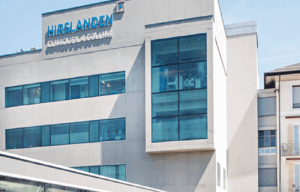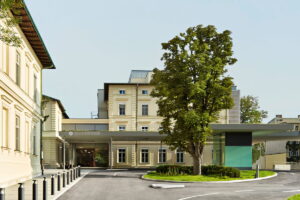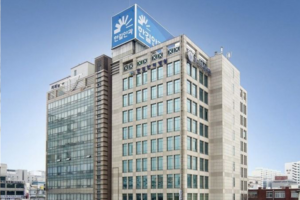Glaucoma
Glaucoma is a group of eye diseases characterized by increased intraocular pressure. As the condition progresses, irreversible changes occur in the retina, leading to optic nerve dysfunction.
Glaucoma is the second leading cause of blindness worldwide (after cataracts). The disease often manifests after the age of 60, although congenital and juvenile forms also exist.
Depending on the mechanism of increased intraocular pressure, glaucoma is classified into:
- Angle-closure glaucoma
- Open-angle glaucoma (the most common form, accounting for up to 90% of cases)
Symptoms indicating the need for diagnosis and treatment
In its early stages, glaucoma is often asymptomatic. Patients usually seek medical attention only when noticeable symptoms appear.
Symptoms of open-angle glaucoma:
- Decreased vision in low-light conditions
- Headaches
- Floating black spots (“flies”) in the field of vision
- Rainbow-colored halos around lights
- Blurred vision
- Pressure sensation in the eyebrow area
Symptoms of angle-closure glaucoma:
- Discomfort when moving the eyes
- Rainbow-colored halos around lights
- Acute attacks may include sudden severe eye pain, eye redness, nausea, and a hardened eyeball
Diagnostic and treatment
Diagnostic
To diagnose glaucoma, ophthalmologists at leading clinics perform a series of examinations, including:
- Standard and daily tonometry (to measure intraocular pressure)
- Elastotonometry (assessment of intraocular fluid pressure)
- Electronic tonography (evaluation of ocular hydrodynamics)
- Gonioscopy or eye ultrasound (assessment of the anterior chamber angle)
- Ophthalmoscopy (evaluation of the optic nerve condition)
In complex clinical cases, advanced diagnostic equipment is used, including laser ophthalmoscopy and optical coherence tomography (OCT).
Treatment
The primary goal of glaucoma treatment is to normalize intraocular pressure, which, in some cases, can be managed with medication. If pressure stabilization cannot be achieved through drug therapy, surgical interventions such as lens replacement or laser treatment are performed.
Innovations in global clinics
An innovative alternative to conventional glaucoma surgery is the Trabectome procedure, a minimally invasive micro-surgical technique developed in the U.S. to balance intraocular pressure. Trabectome can significantly slow the progression of glaucoma or even lead to full recovery.
Procedures
Top clinics
-
 Istanbul, Turkey Acıbadem Ataşehir Clinic
Istanbul, Turkey Acıbadem Ataşehir Clinic -
 Seoul, South Korea Asan Medical Center
Seoul, South Korea Asan Medical Center -
 Jerusalem, Israel Hadassah Medical Center
Jerusalem, Israel Hadassah Medical Center -
 Petah Tikva, Israel Medical Center “Rabin”
Petah Tikva, Israel Medical Center “Rabin” -
 Geneva, Switzerland Hirslanden Clinique La Colline
Geneva, Switzerland Hirslanden Clinique La Colline -
 Geneva, Switzerland Generale-Beaulieu
Geneva, Switzerland Generale-Beaulieu -
 Antalya, Turkey Hospital Medical Park Antalya
Antalya, Turkey Hospital Medical Park Antalya -
 Dubai, UAE NMC Healthcare
Dubai, UAE NMC Healthcare -
 Istanbul, Turkey Hospital “Memorial Şişli”
Istanbul, Turkey Hospital “Memorial Şişli” -
 Milan, Italy San Raffaele University Hospital
Milan, Italy San Raffaele University Hospital -
 Graz, Austria Leech Private Hospital
Graz, Austria Leech Private Hospital -
 Abu Dhabi, UAE Burjeel Hospital Abu Dhabi
Abu Dhabi, UAE Burjeel Hospital Abu Dhabi -
 Vienna, Austria Debling Private Clinic
Vienna, Austria Debling Private Clinic -
 Vienna, Austria Confraternität Private Hospital
Vienna, Austria Confraternität Private Hospital -
 Dubai, UAE Burjeel Hospital
Dubai, UAE Burjeel Hospital -
 Incheon, South Korea Hangil Ophthalmology Clinic
Incheon, South Korea Hangil Ophthalmology Clinic -
 Incheon, South Korea Gil Medical Center at Gachon University
Incheon, South Korea Gil Medical Center at Gachon University -
 Lausanne, Switzerland Clinique Montchoisy
Lausanne, Switzerland Clinique Montchoisy -
 Nyon, Switzerland Clinique Genolier
Nyon, Switzerland Clinique Genolier -
 Bodrum, Turkey Acibadem Bodrum Hospital
Bodrum, Turkey Acibadem Bodrum Hospital -
 Barcelona, Spain QuironSalud Barcelona Hospital
Barcelona, Spain QuironSalud Barcelona Hospital -
 Barcelona, Spain Dexeus University Hospital
Barcelona, Spain Dexeus University Hospital -
 Barcelona, Spain Medical Center "Teknon"
Barcelona, Spain Medical Center "Teknon" -
 Barcelona, Spain Sant Joan de Deu Children's Hospital
Barcelona, Spain Sant Joan de Deu Children's Hospital -
 Barcelona, Spain University Hospital Barnaclinic+
Barcelona, Spain University Hospital Barnaclinic+ -
 Madrid, Spain University Clinic HM Madrid
Madrid, Spain University Clinic HM Madrid -
 Madrid, Spain University Hospital HM Monteprincipe
Madrid, Spain University Hospital HM Monteprincipe -
 Düsseldorf, Germany Breyer, Kaymak, and Klabe Eye Surgery Clinic
Düsseldorf, Germany Breyer, Kaymak, and Klabe Eye Surgery Clinic -
 Hamburg, Germany Asklepios Klinik Barmbek
Hamburg, Germany Asklepios Klinik Barmbek -
 Zurich, Switzerland Hirslanden Clinic
Zurich, Switzerland Hirslanden Clinic -
 Madrid, Spain Quiron Salud University Hospital
Madrid, Spain Quiron Salud University Hospital -
 Seoul, South Korea Samsung Medical Center
Seoul, South Korea Samsung Medical Center -
 Seoul, South Korea Medical Center at Ewha Womans University
Seoul, South Korea Medical Center at Ewha Womans University -
 SNUH
SNUH

































